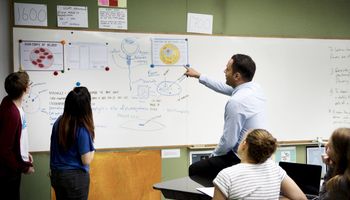Writing a lesson plan is one of the most essential and basic skills a teacher needs to have in order to be effective in the classroom. But many of us find a struggle, especially in the early days of our careers. But there are some simple steps that you can take to make your lesson plans as good as they can be and to make them useful in creating learning experiences for pupils.
1. GOOD FORM, OLD THING! – Most schools now have their own forms for teachers to use for their planning with clearly defined terms and layouts, and these can vary from school to school. Always follow the school policy and ask the member of staff in charge of curriculum matters for clarification or support if need it. After all, they are there to make sure you get things right and they also want you to succeed. Looking at online examples can really help. Good old twinkl.co.uk has a great standard format and downloadable lesson plans. TES resources (https://www.tes.com/teaching-resources) has downloadable lesson plans too and some of them are free (I’ve posted a few freebies, and you can find one of them if you follow the link here: https://www.tes.com/teaching-resource/what-makes-a-story-11809440). Microsoft Word has templates, but they are a bit American, which can either be your thing, or not.
2. GET THE DETAILS RIGHT – Make sure that you include: Subject (e.g. English), Topic (e.g. Shakespeare), your name and that of your assistant(s), date and time. This will help you keep track of the lesson plan in your file (physical or virtual). If dates and times change, for whatever reason, make a note of the new details.
3. PUT IT IN CONTEXT – When writing your lesson plan, refer to what Context or Prior Knowledge is expected for the lesson. You don’t need to write more than a sentence or two, but indicating expectations will demonstrate that you’ve thought about where you see the lesson sitting in the sequence of progression for the children. One lesson should introduce a concept or a theme, and subsequent lessons should work on that prior knowledge. Name the children who need extra support to perform better in the areas which were covered in previous sessions or those who performed especially well and can be taken a step beyond most of their peers.
4. AIM STRAIGHT, AIM HIGH – Set your aims and success criteria/learning objectives at the start of the lesson plan. Make them clear, concise and achievable. Remember that the aims are what you want children to achieve (sentences should start with ‘to’, such as ‘to learn number pairs that make 10’) and learning objectives/success criteria are what the children should have achieved by the end of the lesson (‘I can’ statements, like ‘I can state pairs of numbers that make 10’).
5. THE ABCs OF THE ABCs:
a. Introduce children to what they are going to be learning. It is absolutely crucial that this part is as engaging as possible. If you can’t grab the children’s interest now, you might as well go home. Refer to the lesson’s topic or theme and the LOs and SCs.
b. Next, the class demonstration/teaching session – this can be a video, powerpoint, you giving the benefit of your knowledge, a teacher-led class discussion, whatever suits you best. Get videos from ANY source ready beforehand if you can. A GREAT place to start with videos is YouTube. Take care to check the adverts. Something visual is a really fun way to start lessons, and twinkl.com do brilliant Maths Mastery sessions and power points that act as lesson starters and discussions. Music is always an appealing way to focus the mind and to get children thinking. I’ve used ‘Wear Sunscreen’ by Baz Luhrmann more than once, and you can find lots of music for free via You Tube, Spotify or Amazon Music Prime, which can relate to what you are covering. Interactive games for whiteboards are lots of fun too, but remember to check them out before trying with children in the classroom to ensure their suitability: go to https://www.topmarks.co.uk/ for a great site. Wales have the Hwb for teachers https://www.ewc.wales/learningexchange/index.php/en/resources/browse-resources-by-subject and this is a brilliant place to start looking for resources as well as lesson plans and more.
c.The pupil activity – differentiation is the key word here. Ensure that you have prepared something suitable for everyone to keep them not only occupied and make them feel supported. Twitter has an ever growing and lively teaching community. One of the best teachers to follow is Teacher Toolkit @teachertoolkit – a senior teacher and someone that dispenses common sense advice about activities. Make sure you include exactly what you expect the children to achieve during the session. If you want them all to write at least five correctly demarcated sentences, write that, but explain if you want more or less from certain individuals or groups.
d.Bringing it together – devote time to planning something worthwhile and take time to make this happen. If it gets squeezed out immediately after a session, make time for it later. A plenary session is equally important but often gets neglected.
6.AND ANOTHER THING – The one thing that I find useful is a resources list. Include worksheets and the physical resources, but also hyperlinks to websites and files in your PC, to help you find those online or downloaded resources and links. This may seem like an unnecessary use of time when you are constructing your plan, but you’ll be thanking yourself in the classroom later.
7.THE FINAL WORD – ASSESSMENT. This has nothing to do with performance of the children or of the teacher.It’s purely about how well the lesson plan itself worked. It can be about the bits that you didn’t have time for, the bits that worked and didn’t work so well (and why). Be aware that some days go better than others, so don’t take anything personally. Making a couple of notes will help you when you come back to the topic again or pass on notes to a colleague about how the lesson went. This is especially useful if you are a supply teacher or in a job share/team teaching situation, where someone else is sharing teaching responsibilities with you.
I hope these notes help you with your plans. Teaching is a fast paced, ever changing world. The more you plan, and work on your planning, the easier it becomes. Your plans are just that, yours. Own them. Look for advice, follow the guidance you are given, look for good ones to give you inspiration. Make them useful for you, the people that use them with you, and above all, the children. After all, children are the most important and if you can engage and enlighten them, the universe is unfolding as it should.




